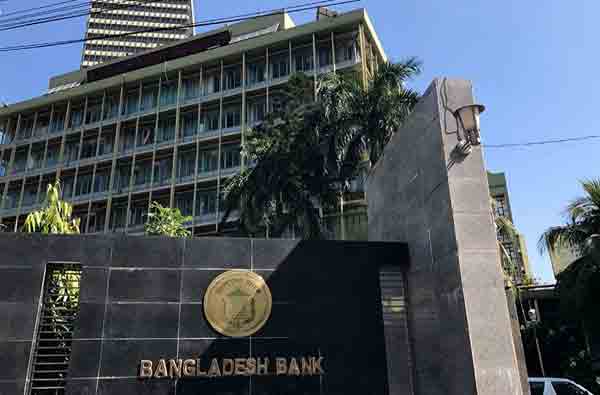
 Dhaka, Bangladesh (BBN)- Managing higher non-performing loans (NPLs) and tight liquidity condition on the domestic front alongside external challenges are likely to pose downside risk to growth momentum, the central bank has said.
Dhaka, Bangladesh (BBN)- Managing higher non-performing loans (NPLs) and tight liquidity condition on the domestic front alongside external challenges are likely to pose downside risk to growth momentum, the central bank has said.
The external challenges include sluggish global growth, disrupting supply chain by the escalating trade war, Brexit- related uncertainty and rising geopolitical tension.
“A coordinated monetary and fiscal policy is required ensuring growth momentum and stable inflation,” the Bangladesh Bank (BB) said in its latest quarterly report for April-June.
Interest rates on both deposit and lending showed some upward nudge, according to the report, released on Wednesday.
The weighted average interest rates on deposit and lending increased to 5.43 per cent and 9.58 per cent in the final quarter (Q4) of the fiscal year (FY) 2018-19 from 5.35 per cent and 9.5 per cent respectively in the previous quarter of the same FY, according to the report.
Among other indicators, gross non-performing loans (NPL) in the banking system decreased slightly to 11.7 per cent in Q4 of FY ’19 from 11.9 per cent three months ago with improving asset quality in the foreign banks and state-owned banks, it explained.
The amount of NPLs increased by BDT 15.52 billion to BDT 1124.25 billion as on June 30, 2019 from BDT 1108.73 billion three months before, the BB data showed. It was BDT 939.11 billion as on December 31, 2018.
The classified loans cover substandard, doubtful and bad/loss portions of total outstanding credit, which stood at BDT 9,620.77 billion on June 30 last. The amount was BDT 9,337.27 billion three months ago.
“To reduce NPLs at a tolerable level remain one of the prime concerns for banking sector stability,” the central bank said in the quarterly report.
The central bank also said banks should take a special drive to recover the stressed assets.
“Enforcement of prudential policies and judicial supervision with political commitment are needed to handle these stressed assets,” the BB noted.
Senior economists and experts suggested the policy makers take “effective measures” to address the higher NPL in the country’s banking sector immediately.
The ongoing economic growth momentum along with financial stability may hamper if the upward trend in NPLs continues, they warned.
Talking to the BBN, former director general of the Bangladesh Institute of Development Studies (BIDS) Mustafa K Mujeri said recovery of classified loans should be strengthened with legal reforms if necessary.
Unless the issue of NPLs is addressed with urgency, the banking system will not be able to play its role in the country’s transition to the middle income status, Mr. Mujeri, a former chief economist of the central bank, added.
The report also said notwithstanding a strong growth in government borrowings from the banking system and the turnaround of the net foreign asset (NFA), broad money (M2) registered a modest growth of 9.9 per cent at the end of FY ’19 against the programmed ceiling of 12 per cent, due mainly to decelerated credit growth in the private sector.
The modest growth in private credit helped reduce the stress on the liquidity condition in the banking system during the October-December period of FY ’19 in spite of subdued deposit growth.
“Nonetheless, interest rates in the inter-bank money market and yields on various government securities went up during this quarter,” the BB added.
The central bank of Bangladesh is expecting that the growth rate of the country’s Gross Domestic Product (GDP) will achieve 8.20 per cent target by the end of FY ’20 despite a number of downside risks.
“Looking ahead, economic growth outlook is expected to remain strong at the targeted level (8.2 per cent) and inflation remains at below the targeted level (5.5 per cent) in FY ’20,” it noted.
In FY ‘19, Bangladesh economy maintained a strong growth momentum with stable inflation, amidst subdued global growth emanated mainly from the escalating trade tension, rising geopolitical tension, and the Brexit related uncertainty.
Bangladesh Bureau of Statistics (BBS)'s provisional estimate shows that real GDP grew by 8.13 per cent in FY ‘19 up from 7.86 per cent in the previous fiscal, supported largely by the pickup in the investment demand, particularly public investment and robust export growth.
On the production side, the growth surge emerged mainly from the industry sector at 13.02 per cent with 14.76 per cent growth in manufacturing activities.
At the same time, activities in the service and agriculture sectors remained firm at 6.50 per cent and 3.51 per cent growth, respectively in FY ‘19.
On the fiscal side, a rise in the government expenditure against a moderate revenue collection led budget deficit to 4.5 percent of GDP in FY ‘19.
Though deficit financing mostly relied on non-bank borrowing, borrowing from the banking system by the government went up in the final quarter of the outgoing fiscal, according to the report.
BBN/SSR/AD